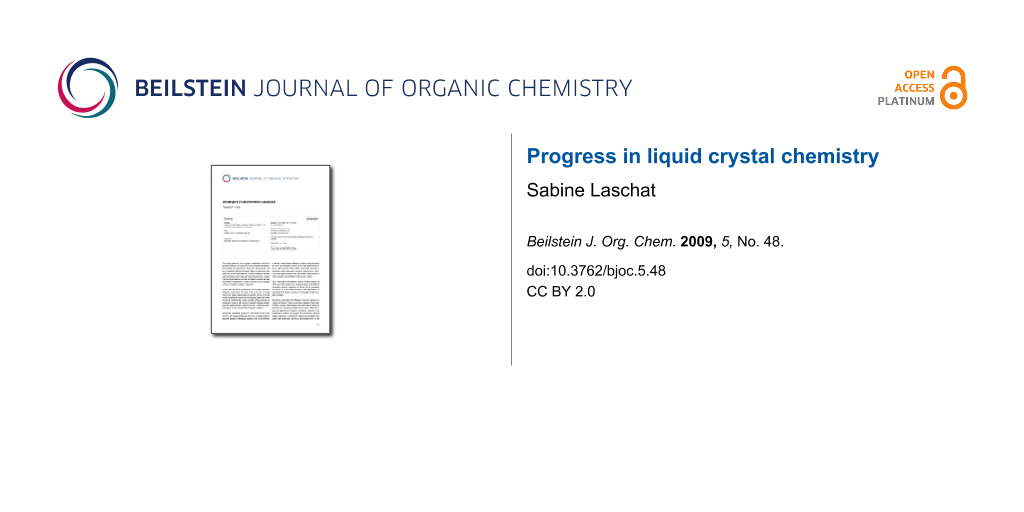Since their discovery in 1888 by the botanist Friedrich Reinitzer, who studied the melting behavior of cholesteryl benzoates, liquid crystals have developed from a mere curiosity to a highly interdisciplinary research field, with LC displays being the most important application to date [1,2]. However, besides the use of thermotropic liquid crystals for display technology many other applications will probably be on the market in the near future, such as organic light emitting diodes, photovoltaic devices, organic field effect transistors, gas sensors etc. [3-8]. One of the major issues in liquid crystal research today is still the poor knowledge of structure-property relationships and thus the synthesis of whole series of structurally related compounds is required in order to allow the design of liquid crystalline and other physical properties. It is the goal of this thematic series “Progress in Liquid Crystal Chemistry” to give the reader of Beilstein Journal of Organic Chemistry a flavor of the synthetic challenges of liquid crystal research, as well as interdisciplinary aspects from material science, physics, physical and theoretical chemistry. It is a great pleasure to serve as a guest editor for this thematic series, where leading experts from all over the world have contributed original research papers and accounts that deal with diverse topics such as phthalocyanine-fullerene hybrid materials for photovoltaic devices, functional metallomesogens, coaxial electrospinning of liquid crystal-containing microfibers, banana-discotic hybrid systems, ionic liquid crystals, relations between molecular length distribution and formation of smectic phases, nematic phase engineering by using V-shaped molecules, saddle-shaped columnar systems displaying anomalous odd-even effects, theoretical studies on the origin of chirality transfer in liquid crystalline host-guest systems, liquid crystalline carboranes and dyes and discotic phenanthrene quinones. Many new exciting discoveries in this diverse research area are to be expected in the near future and our aim with this Thematic Series is to attract a new audience to this topic.
Sabine Laschat
Guest Editor
References
-
Reinitzer, F. Monatsh. Chem. 1888, 9, 421–441. doi:10.1007/BF01516710
Return to citation in text: [1] -
Sluckin, T. J.; Dunmur, D. A.; Stegemeyer, H. Crystals that flow: Classic papers from the history of liquid crystals; Taylor & Francis: London, 2004.
Return to citation in text: [1] -
Sergeyev, S.; Pisula, W.; Geerts, Y. H. Chem. Soc. Rev. 2007, 36, 1902–1929. doi:10.1039/b417320c
Return to citation in text: [1] -
Tschierske, C. Chem. Soc. Rev. 2007, 36, 1930–1970. doi:10.1039/b615517k
Return to citation in text: [1] -
Donnio, B.; Bruce, D. W. Struct. Bonding 1999, 95, 193–247. doi:10.1007/3-540-68118-3_5
Return to citation in text: [1] -
Laschat, S.; Baro, A.; Steinke, N.; Giesselmann, F.; Hägele, C.; Scalia, G.; Judele, R.; Kapatsina, E.; Sauer, S.; Schreivogel, A.; Tosoni, M. Angew. Chem. 2007, 119, 4919–4973.
Angew. Chem. Int. Ed. 2007, 46, 4832–4887. doi:10.1002/anie.200604203
Return to citation in text: [1] -
Kato, T.; Yasuda, T.; Kamikawa, Y.; Yoshio, M. Chem. Commun. 2009, 729–739. doi:10.1039/b816624b
Return to citation in text: [1] -
Simpson, C. D.; Wu, J.; Watson, M. D.; Müllen, K. J. Mater. Chem. 2004, 14, 494–504. doi:10.1039/b312789c
Return to citation in text: [1]
| 1. | Reinitzer, F. Monatsh. Chem. 1888, 9, 421–441. doi:10.1007/BF01516710 |
| 2. | Sluckin, T. J.; Dunmur, D. A.; Stegemeyer, H. Crystals that flow: Classic papers from the history of liquid crystals; Taylor & Francis: London, 2004. |
| 3. | Sergeyev, S.; Pisula, W.; Geerts, Y. H. Chem. Soc. Rev. 2007, 36, 1902–1929. doi:10.1039/b417320c |
| 4. | Tschierske, C. Chem. Soc. Rev. 2007, 36, 1930–1970. doi:10.1039/b615517k |
| 5. | Donnio, B.; Bruce, D. W. Struct. Bonding 1999, 95, 193–247. doi:10.1007/3-540-68118-3_5 |
| 6. |
Laschat, S.; Baro, A.; Steinke, N.; Giesselmann, F.; Hägele, C.; Scalia, G.; Judele, R.; Kapatsina, E.; Sauer, S.; Schreivogel, A.; Tosoni, M. Angew. Chem. 2007, 119, 4919–4973.
Angew. Chem. Int. Ed. 2007, 46, 4832–4887. doi:10.1002/anie.200604203 |
| 7. | Kato, T.; Yasuda, T.; Kamikawa, Y.; Yoshio, M. Chem. Commun. 2009, 729–739. doi:10.1039/b816624b |
| 8. | Simpson, C. D.; Wu, J.; Watson, M. D.; Müllen, K. J. Mater. Chem. 2004, 14, 494–504. doi:10.1039/b312789c |
© 2009 Laschat; licensee Beilstein-Institut.
This is an Open Access article under the terms of the Creative Commons Attribution License (http://creativecommons.org/licenses/by/2.0), which permits unrestricted use, distribution, and reproduction in any medium, provided the original work is properly cited.
The license is subject to the Beilstein Journal of Organic Chemistry terms and conditions: (http://www.beilstein-journals.org/bjoc)








